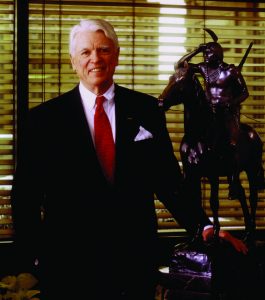12 Crosby Kemper Educational Wing and UMB Theater
By Kelly Yarbrough

In 1994 Kansas State University was $4.5 million into its $5 million fundraising goal for the new Marianna Kistler Beach Museum of Art. But construction would only begin once the entirety of that goal was met.
By the 1990s the Kemper family had been well established in Kansas City as a banking and philanthropy powerhouse. Rufus Crosby Kemper Jr. was the son of R. Crosby Kemper and began his rise as a young president of United Missouri Bank (later to become UMB Financial Corporation). Over the next decades, Kemper Jr. would prove himself an adept businessman and dedicated supporter of the arts and culture of the Kansas City region.
Crosby Kemper Jr. considered himself a “maverick” in the world of philanthropy because he was willing to invest where he saw value, regardless of what others saw. He also motivated others to give when they were hesitant. In the 1980s Crosby was essential to the survival of several Kansas City civic assets, including the Marriott hotel on 12th Street (an anchor for the once struggling downtown) and the Kansas City Symphony. Crosby almost single-handedly saved the Symphony because he believed it was important for Kansas City to have this institution for its own. In addition to giving generously to art institutions locally and nationally, Crosby also had a passion for agribusiness. As a Kansas City native, he saw the importance of agriculture in the city’s history and growth, continuing a legacy of Kemper giving to the Kemper Arena in the Stockyards District and establishing the Agriculture Future of America organization.
In April 1994 it was announced that the yet-realized Marianna Kistler Beach Museum of Art was $500,000 closer to its fundraising goal thanks to Crosby Kemper Jr. Kemper’s UMB Bank had recently expanded into the Manhattan community, and the gift was intended for the development of an educational wing and auditorium in the new museum. As a result, when the Beach Museum of Art opened in 1996 it included the Crosby Kemper Educational Wing and the UMB Theater on the upper level in recognition of Kemper’s generosity. The Lou Ann McKinnon Dunn Activities Center is located on the first floor underneath the theater. This was not Crosby’s only gift to the museum — the acquisition of a number of works in the Beach Museum of Art’s collection, including the dramatic Dale Chihuly sculpture in the main staircase, were made possible by his support.
Kemper and wife “Bebe” were avid art collectors themselves, eventually donating over three hundred pieces from their personal collection to start the Kemper Museum of Contemporary Art in 1994. Bebe herself was an artist, and Crosby often trusted her eye to find new talent. The Kempers were also friends with several notable artists, including the hero of the Regionalism movement, Thomas Hart Benton, and the Wyeth family in Pennsylvania. Indeed, the Kempers’ interest in art went far beyond the value of a good investment. In Crosby’s own words, “The fun of collecting is in the storytelling…my joy is to live in a beautiful environment. The future of civilized life is enhanced by the good influence we have on other people and in the arts; all else is immaterial.”
By this measure, R. Crosby Kemper Jr. certainly has left behind a lasting legacy.

